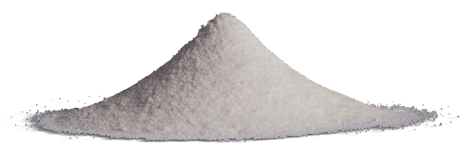SODIUM SULFATE
Overview:
First discovered in Austria, sodium sulfate was once known as "Miraculous Salt" and was used in 18th century Europe as a medicinal cure for a variety of ailments. Sodium sulfate has evolved through a series of uses since then. Sodium sulfate was long an important material in the manufacture of various detergents and paper. However, changes in both end user applications and regulatory guidelines have reduced the role of sodium sulfate in those industries. Relatively inexpensive and useful as both a filling and leveling agent, sodium sulfate is now used in the manufacture of glass and textiles and is finding new use as part of the gold recovery process from electronic products.
The majority of the sodium sulfate produced globally is from the natural mineral form mirabilite, found mainly in Canadian, Russian and U.S. lake beds. However, sodium sulfate is also a byproduct from various chemical processes, such as battery acid recycling, or silica pigment refining. Technically a waste product, the sodium sulfate from these processes is marketed for the same applications as naturally occurring sodium sulfate.1
Characteristics and Challenges:
Most grades of sodium sulfate have an average bulk density of 85 lb. /cu ft 2, making it a very dense material. Sodium sulfate is also abrasive. As a result, conveying equipment must be rugged enough to handle a material with these characteristics.
Sodium sulfate is generally free-flowing and crystalline in form. It is also hygroscopic, meaning that humidity and temperature may impact its flow.
If the sodium sulfate is being pneumatically conveyed into a processing system, the blower used to move sodium sulfate through the air line must be sized to meet the demands of the system. Sodium sulfate tends to absorb moisture from the air. If this issue causes excessive clumping, additional devices may be required to reduce the humidity levels or draw moisture from the material prior to its entrance into the conveyor.
If the sodium sulfate is being added to the process out of bulk bags, the frames used to discharge the bags may require additional accessories. The need for these devices may vary, based on the grade of sodium sulfate being conveyed, as well as the type of bag. In areas of high humidity, additional equipment may be needed to serve as an air and moisture-tight seal, protecting the sodium sulfate from airborne aerosols and other contaminants.
The geometry of the feed hoppers is another important aspect. To ensure proper flow of the sodium sulfate into the charging adaptor, there may be a need to incorporate devices such as vibrators or mechanical agitators to promote flow. A hopper screen above the receiving vessel will help protect the operators if the sodium sulfate is being dumped manually into a hopper that is equipped with agitating devices.

Due to Sodium Sulfate's granular or crystalline form and its free flowing nature, a round screw design is commonly used for flexible screw conveying. Should your sodium sulfate application feature the loading the material into bulk bags, the bag capacity will be maximized by use of a vibratory densification deck to level the sodium sulfate as it fills the bag and by the application of load cells to attain the desired weight. Seals and other dust containment devices will ensure a dust-tight and moisture-tight operation.
Flexicon Applications:
Consultation with a Flexicon specialist will help you decide if a flexible screw or pneumatic solution best fits your Sodium Sulfate application. Flexicon's expert design and engineering staff will weigh each parameter and recommend the best solution for you. Upon request, Flexicon's test lab will simulate your Sodium Sulfate handling applications before the system is installed in your plant.
A Flexicon-designed and manufactured system replaced the manual bag dumping of Sodium Sulfate with an automated process that includes a bulk bag discharger and round stainless steel screw, which boosted our client's production output by 50%.Since the moisture is absorbed from the air, Flexicon's airtight flexible screw conveyor systems will eliminate clogging, enhance productivity and reduce the time and effort needed to clean the system.
Related Articles on Sodium Sulfate:
1 United States Geological Survey, Sodium Sulfate Statistics and Information
2 Powder Bulk Solids Bulk Density Chart
Sources: Where noted. All other information courtesy of Flexicon Corporation.